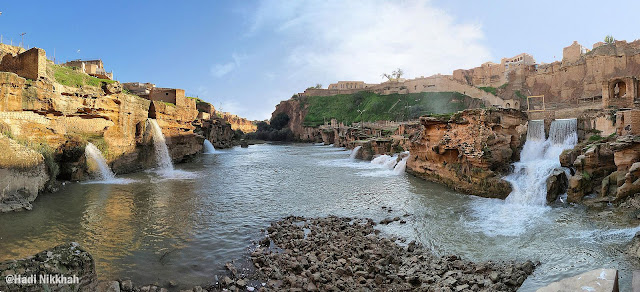The Shushtar hydraulic system is located in Shushtar and dates back to the time of the Achaemenid king Darius the Great in the 5th century BCE. It is a spectacular complex of rivers, waterways, dams, waterfalls and canals. It involves two main diversion canals on the Karoon River one of which, the Gargar canal, is still in use providing water to the city of Shushtar via a series of tunnels that supply water to mills. Also known as Mianab, the site includes the Salasel Castle, damns, bridges, basins and mills, the operation centre of the hydraulic system as well as the tower where the water level is measured.
The system forms a cliff from which water cascades into a downstream basin and enters south of the city enabling the people of Shushtar to plant orchards and create farms over an area of 40,000 hectares. This amazing system was developed from earliest times and many examples of it are still in place around Shushtar. It has served the area for thousands of years and was still in use as recently as a few decades ago when it began to fall into disrepair and was eventually abandoned. The structures were used as an irrigation system and encouraged cultural interactions in the region. The waterfalls presented visitors a beautiful unique landscape, enjoying a water engineering technology rare for that point in history.
While the Shushtar water system may have its roots in the Achaemenid times (such as the construction of the artificial Daryoon Canal), however, much of its renovation and expansion was done by the Sassanids. The Gheysar dam was built during Shapur the First’s time in order to regulate the water flow into 6 equal portions. Much of the construction was done by Roman soldiers captured by Shapur following battle with the Roman Emperor Valerian. Another artificial water way in place is the Gargan Canal that branches off of Karoon and after approximately 80 kilometers rejoins it. Along Gargan’s path it enters many tunnels and feeds adjoining watermills. While the Sassanids have been credited with its creation, however, the many Ashkani artifacts in its vicinity hints at an even older origin. The Salasel Castle was used up until the Qajar Era as the main headquarter for managing and supervising the smooth running of the hydraulic system along this way.
Of course the main attraction of the water system is its waterfalls. As a result of the dam on the Gargan waterway, the water level significantly rises and subsequently enters three manmade canals carved through the rocky surroundings. Once inside the canals, water is branched off in many directions and ultimately ends up feeding the watermills before exiting on the other side and pouring down into the water pools.
There were approximately 40 watermills constructed in the general area of the water falls although many of them have been destroyed with the passing of time and lack of maintenance. Nevertheless much use has been made of the remaining mills. In 1933 on the northern side of the area, an electric company was founded fully utilizing the existing system. Also in 1955 on the west end, an ice factory was built.
Today, the system has been replaced by several dams built in accordance with modern technological methods. As with the old system, these have served the purpose of controlling the river and storing its waters for irrigation, as well as the production of electricity today.
The Shushtar Historical Hydraulic System in Iran's Khuzestan Province was registered on UNESCO's list of World Heritage Sites in June of 2009. Merely a few weeks afterwards, the ancient waterfalls of Shushtar were polluted by sewage and sludge being brought by the eight wastewater pipes pouring into the water system in its path by the Water and Sanitation Department. A portion of the Gargar Bridge of the complex was destroyed as result of wastewater leakage and erosion.









Hello,
ReplyDeleteI was wondering if you can help us with some information about a monastery that is said to be near Shushter, which is in turn near Gundishapur in Khuzestan (near the Persian Gulf). It is called Monastery of Rabban Shabur. I want to know if it exists today in ruins or not and how I can locate it.
I will be very gratefully for any information concerning this site.
All the best,
Aura Dontu
auradontu@yahoo.com
I haven't seen anything about it still existing but I'll look into it and see if I can come up with anything.
ReplyDeleteThank you!
ReplyDelete